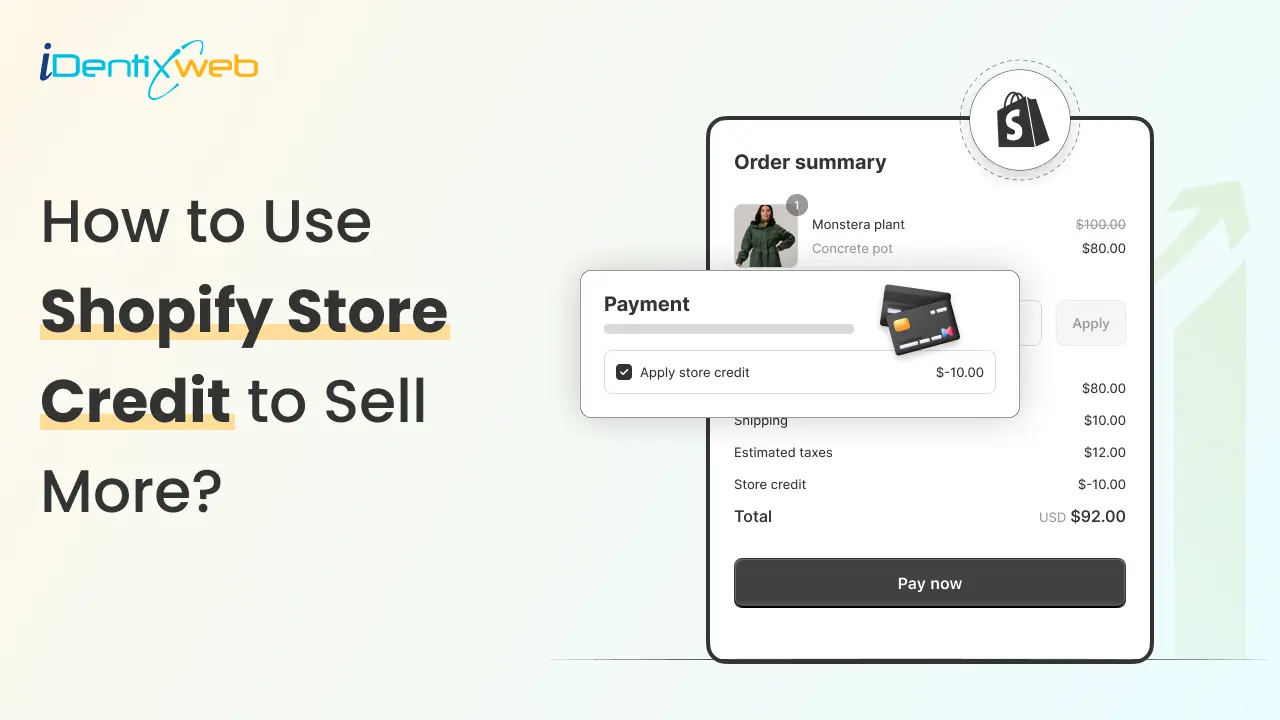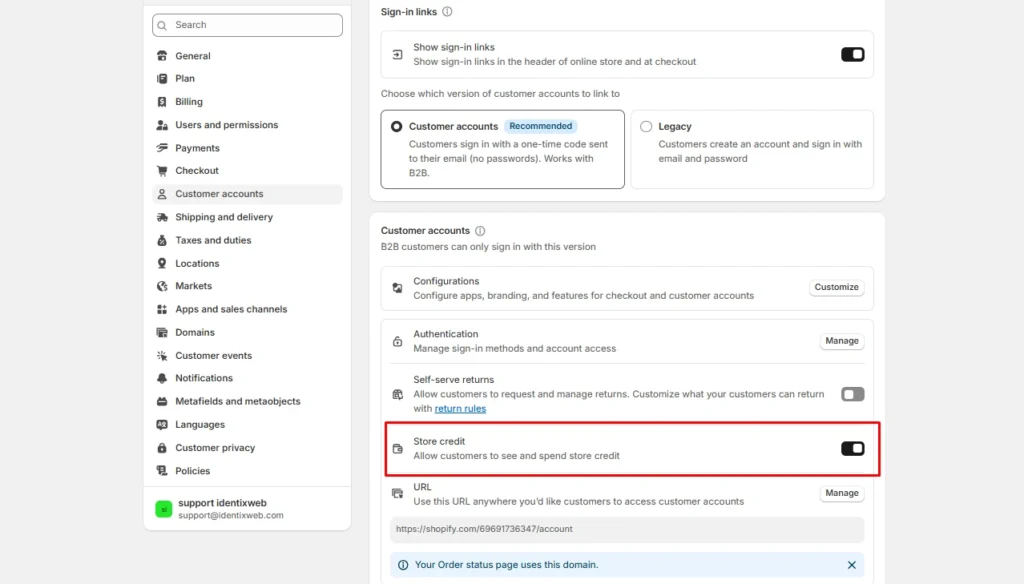
Returns and refunds are every Shopify merchant’s nightmare. They eat into your margins, slow down cash flow, and send customers straight out of your store.
What if I told you there’s a strategic move that helps you keep the cash flow straight to your account?
That’s where Shopify store credit steps in. Instead of watching revenue walk out the door, you can redirect it back into your business. It gives customers the freedom to shop again without dealing with complicated refund processing times. As a Shopify expert, I can guarantee it keeps your revenue cycling within your store.
In this guide, you’ll learn what Shopify store credit is and why it works so well. You will also learn how to give store credit on Shopify in ways that help you boost loyalty, increase repeat purchases.
What is Store Credit for Shopify?
Shopify store credit is a balance you give customers that they can use toward future purchases on your Shopify store instead of receiving a traditional refund.
According to a report by the National Retail Federation, the average return rate is 16.9%. Store credit helps merchants decrease this exact number.
- It acts like a digital wallet that keeps revenue inside your store.
- Customers can redeem the credit on any eligible product at checkout.
- It offers a faster, more flexible alternative to refunds while improving long-term customer value.
Shopify apps like iCart help you upsell effectively because they turn your cart into a sales driver. It offers pre-checkout upsell, product bundles, free gift triggers and a sticky slide cart that keeps the add-to-cart momentum going.

Why Shopify Merchants Love Store Credit?
Shopify merchants prefer store credit because it keeps revenue inside the business instead of flowing back through refunds. There are many more reasons why they love store credits.
Faster Access to Value
- Customers don’t have to wait days for a refund to hit their bank account.
- They can instantly use their credit for a new purchase.
More Control Over Their Shopping
- Store credit lets shoppers choose any product instead of being forced into a direct exchange.
- It gives them the freedom to browse and decide at their own pace.
A Better Overall Experience
- Customers feel they’re being compensated fairly without the hassle of refund delays.
- It turns a negative event like a return into a smoother, frustration-free moment.
What Are the Types of Store Credit Shopify Merchants Use?
Loyalty & Rewards Credit
- Customers earn store credit as a reward for actions like placing orders, leaving reviews, or referring friends.
- From the shopper’s point of view, it feels like a reward they have earned by being a loyal customer.
Return & Exchange Credit
- This is the classic version. Instead of sending money back to a card, you give customers store credit when they return an item. This way, they can pick something else they actually love.
- It softens the pain of returns for shoppers while keeping the value inside your Shopify store.
Compensation / Goodwill Credit
- When something goes wrong, like delayed shipping or a missing item, you can offer store credit as a make-good.
- Customers feel taken care of, and instead of walking away frustrated, they’re encouraged to give your store another chance.
Gift Card Credit
- Gift cards on Shopify act as store credit that customers can spend whenever they’re ready.
- They’re perfect for gifting, last-minute purchases, or shoppers who aren’t sure what to choose yet. They often lead to bigger carts because customers tend to spend more than the gift card balance.
Does Shopify have a Store Credit Feature?
Yes. Shopify has a built-in store credit feature that lets you enable and track store credits. Shopify treats store credit as a payment method that’s tied directly to a customer account, and you control how it’s issued, shown, and redeemed from your admin.
Built-in Store Credit in Customer Accounts
- Shopify’s store credit is turned on by default for stores using the new customer accounts. In case it’s not, navigate to Settings > Customer accounts > Enable Store credit

Store Credit at Checkout and in POS
Once store credit is active, Shopify treats it like a payment method your customers can select at checkout.
- When a logged-in customer has credit, Shopify automatically shows it as a way to pay for their order online.
- You can also accept store credit in-store with Shopify POS, and even decide whether it should be available in POS separately from your online store.
- The system updates balances automatically after each order, so you’re not manually tracking anything.
Tracking, Permissions, and Controls
Shopify also gives you the admin controls you need to track and manage Shopify store credits.
- You can set staff permissions so that only specific team members can manage store credit.
- Every use of store credit shows up in order timelines and customer records, so you can always see when and how it was applied.
- Shopify’s terms make it clear that you, as the merchant, own and manage store credit and gift card liability. You can align it with your financial and accounting processes.
Read the detailed Shopify store credit guide to manage it in your store.
Strategies for Customer Retention with Shopify Store Credit
Make store credit the default outcome for returns
If your store defaults to the original payment method, you are missing out on revenue. Instead, position Shopify store credit as the preferred option in your returns flow:
- In your returns portal, highlight “Store credit” as the first choice.
- Add an automated response to support queries like, “We can issue store credit instantly so you can reorder right away”
Add bonus credit to reward exchanges over refunds
If you want shoppers to choose store credit willingly, sweeten the deal.
For example, “Choose store credit and get an extra $5” is a great way to both provide store credits and offers to the customer.
Turn store credit into a part of your loyalty program
If you’re running a loyalty program, store credit is often more powerful than points.
Loyalty Shopify apps like Yotpo Loyalty Rewards Program show that rewards are directly tied to repeat purchases and LTV.
Why does it boost retention
- Customers understand and value store credit more than point balances.
- It keeps shoppers cycling back to your site to redeem and then spend more.
Conclusion: Build Long-Term Loyalty With Store Credit
Shopify store credit works as a powerful retention tool because it keeps shoppers engaged. It also encourages them to return without relying on heavy discounts.
When you use it strategically across returns and loyalty rewards, it helps build a stronger and more predictable customer base.
For Shopify merchants, the real value comes from how easily store credit supports repeat purchases and boosts CLV. Start with simple credit workflows, track how your customers respond, and adjust your approach over time. You’ll see more loyal shoppers, better CLV, and a healthier revenue cycle.
Shopify Store Credit FAQs
1. Does Shopify provide store credit?
Yes, Shopify provides store credit that you can enable in the Customer accounts settings and manage directly from each customer profile. Customers with new customer accounts can see and spend their store credit at checkout when they’re logged in.
2. How to issue store credit on Shopify?
You can issue store credit from your Shopify admin by going to Customers > select a customer > Store credit > Edit > Credit, then entering the amount you want to add to their balance. Once you save it, the credit appears in the customer’s store credit section.
3. What is the difference between a gift card and a store credit on Shopify?
Store credit is tied to a specific customer account and used like a built-in balance at checkout. A gift card is a separate code that anyone can redeem as long as they have the code.
4. Are refund and store credit the same?
No, a refund sends money back to the customer’s original payment method. A store credit keeps the value inside your Shopify store for the customer to use later.
5. Is giving store credit good or bad for Shopify stores?
Giving store credit is generally positive for most Shopify stores because it retains revenue and increases the chances of repeat purchases.
6. What are the benefits of providing store credit on Shopify?
Store credit helps you reduce refund-related revenue loss, keep customers in your store, and nudge them toward repeat purchases. It also integrates cleanly with returns, POS, and loyalty workflows, giving you a flexible way to compensate customers while still protecting margins.



![How Bike Stores Using Shopify Are Winning [Complete 2025 Guide] How Bike Stores Using Shopify Are Winning [Complete 2025 Guide]](/wp-content/uploads/2025/11/17-11-Mon-Blog-Complete-Guide-to-Selling-Bikes-on-Shopify.webp)
![The 20 Best Shopify Beauty Store Examples [Latest Update] The 20 Best Shopify Beauty Store Examples [Latest Update]](/wp-content/uploads/2025/11/14-11-Fri-Blog-The-20-Best-Shopify-Beauty-Stores.webp)


About the author
Vineet Nair
Vineet is an experienced content strategist with expertise in the ecommerce domain and a keen interest in Shopify. He aims to help Shopify merchants thrive in this competitive environment with technical solutions and thoughtfully structured content.